Progressive music
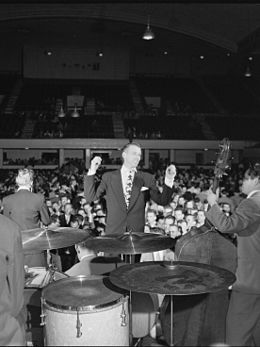
Progressive music is music that attempts to expand existing stylistic boundaries associated with specific
As an
Jazz
Progressive jazz is a form of
Progressive big band is a style of big band or swing music that was made for listening, with denser, more modernist arrangements and more room to improvise. The online music guide AllMusic states that, along with Kenton, musicians like Gil Evans, Toshiko Akiyoshi, Cal Massey, Frank Foster, Carla Bley, George Gruntz, David Amram, Sun Ra, and Duke Ellington were major proponents of the style.[16]
Pop and rock
Definitions
"Progressive rock" is almost synonymous with "
Background
Up until the mid 1960s, individual idiolects always operated within particular styles. What was so revolutionary about this post-hippie music that came to be called 'progressive' ... was that musicians acquired the facility to move between styles—the umbilical link between idiolect and style had been broken.
—Allan Moore[19]
During the mid 1960s, pop music made repeated forays into new sounds, styles, and techniques that inspired public discourse among its listeners. The word "progressive" was frequently used, and it was thought that every song and single was to be a "progression" from the last.
The music was developed immediately following a brief period in the mid 1960s where creative authenticity among musical artists and consumer marketing coincided with each other.[27] Before the progressive pop of the late 1960s, performers were typically unable to decide on the artistic content of their music.[28] Assisted by the mid 1960s economic boom, record labels began investing in artists, giving them freedom to experiment, and offering them limited control over their content and marketing.[11][nb 5] The growing student market serviced record labels with the word "progressive", being adopted as a marketing term to differentiate their product from "commercial" pop.[11]Music critic Simon Reynolds writes that beginning with 1967, a divide would exist between "progressive" pop and "mass/chart" pop, a separation which was "also, broadly, one between boys and girls, middle-class and working-class."[30][nb 6] Before progressive/art rock became the most commercially successful British sound of the early 1970s, the 1960s psychedelic movement brought together art and commercialism, broaching the question of what it meant to be an artist in a mass medium.[31] Progressive musicians thought that artistic status depended on personal autonomy, and so the strategy of "progressive" rock groups was to present themselves as performers and composers "above" normal pop practice.[32][nb 7]
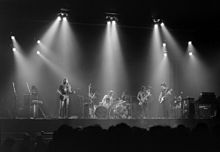
"
Post-progressive
"Post-progressive" is a term invented to distinguish a type of rock music from the persistent "progressive rock" style associated with the 1970s.[40] In the mid to late 1970s, progressive music was denigrated for its assumed pretentiousness, specifically the likes of Yes, Genesis, and Emerson, Lake & Palmer.[41] According to musicologist John Covach, "by the early 1980s, progressive rock was thought to be all but dead as a style, an idea reinforced by the fact that some of the principal progressive groups has developed a more commercial sound. [...] What went out of the music of these now ex-progressive groups [...] was any significant evocation of art music."[42] In the opinion of King Crimson's Robert Fripp, "progressive" music was an attitude, not a style. He believed that genuinely "progressive" music pushes stylistic and conceptual boundaries outwards through the appropriation of procedures from classical music or jazz, and that once "progressive rock" ceased to cover new ground – becoming a set of conventions to be repeated and imitated – the genre's premise had ceased to be "progressive".[43]
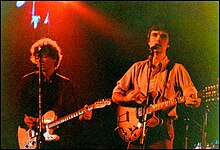
A direct reaction to prog came in the form of the
Soul and funk

"Progressive soul" is used by Martin to refer to a musical development in which many African-American recording artists by the 1970s were creating music in a manner similar to progressive rock.[46] This development inspired greater musical diversity and sophistication, ambitious lyricism, and conceptual album-oriented approach in black pop.[47] Among the musicians at its forefront were Sly Stone, Stevie Wonder, Marvin Gaye, Curtis Mayfield, and George Clinton.[48] According to Geoffrey Himes, "the short-lived progressive-soul movement flourished" from 1968 to 1973 and demonstrated "adventurous rock guitar, socially conscious lyrics and classic R&B melody".[49] Similar to contemporaneous white prog musicians, progressive black musicians in the 1970s directed their creative control toward ideals of "individualism, artistic progression and writing for posterity", according to music academic Jay Keister, who notes that this pursuit sometimes conflicted with the collective political values of the Black Arts Movement.[50]
Among the stylistic characteristics shared from progressive rock in black progressive music of this period were extended composition, diverse musical appropriation, and recording music intended for listening rather than dancing. Rather than the song-based extended compositions and suites of progressive white music, black counterparts in the 1970s generally unified an extended recording with an underlying rhythmic
Electronic
"Progressive electronic" is defined by AllMusic as a subgenre of
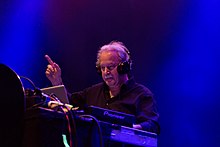
In the mid-1990s, the lowercase movement, a reductive approach towards new digital technologies, was spearheaded by a number of so-called "progressive electronica" artists.[58]
Criticism
Reynolds
Hip hop
"Progressive rap" has been used by academics to describe a certain type of
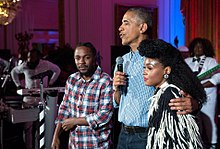
Early works of progressive rap such as the 1982
The UK has also produced notable performers in progressive rap, including
Notes
- ^ According to academic Tim Wall, the most significant example of the struggle between Tin Pan Alley, African American, vernacular and art discourses was in jazz. As early as the 1930s, artists attempted to cultivate ideas of "symphonic jazz", taking it away from its perceived vernacular and black American roots. These developments succeeded in the respect that many people today no longer consider certain forms of jazz as popular music.[13]
- progressive politics, but those connotations were lost early in the 1970s.[18]
- ^ Starting in about 1967, "pop music" was increasingly used in opposition to the term "rock music", a division that gave generic significance to both terms.[20]
- the Edgar Broughton Band's 'Apache Dropout' and Edison Lighthouse's 'Love grows' were released in 1970 with strong Midlands/London connections, and both were audible on the same radio stations, but were operating according to very different aesthetics."[25]
- ^ This situation fell in disuse after the late 1970s and would not reemerge until the rise of Internet stars.[29]
- New Pop movement of the 1980s was an attempt to bridge this divide.[30]
- ^ By 1970, a journalist at Melody Maker highlighted progressive pop as the "most fascinating and recent development" in popular music, writing that the music is "meant for a wide audience but which is intended to have more permanent value than the six weeks in the charts and the 'forget it' music of older pop forms."[33]
- the Sex Pistols, the Clash, and the Ramones adopted a "back-to-basics" stance, embracing the roots of rock music with direct sentiments, simple chord structures, and uncluttered arrangements.[41] While punk rock appeared to be a negation of progressive rock, both styles of music derived from the idea of a cultural alternative.[6]
References
Citations
- ^ a b "Progressive Jazz". AllMusic.
- ^ Willis 2014, p. 219, 'Progressive' music can be seen as an experimentation with alternative routes"; Moore 2004, p. 22, "What was so revolutionary about this post-hippie music that came to be called 'progressive' ... was that ... the umbilical link between idiolect and style had been broken."; Macan 1997, p. 246, "the progressive rock of the 1970s had been 'progressive' only as long as it pushed the stylistic and conceptual boundaries of rock outwards"
- ^ a b c Holm-Hudson 2013, p. 85.
- ^ Guern 2016, p. 33; Martin 1998, p. 41.
- ^ Holm-Hudson 2013, pp. 85–87.
- ^ a b Macan 2005, p. 250.
- ^ Reynolds 2013, pp. 6–7, 16.
- ^ Holm-Hudson 2013, pp. 16, 85–87.
- ^ a b Cotner 2000, p. 90.
- ^ Cotner 2000, p. 93.
- ^ ISBN 978-1-317-05265-4.
- ^ a b c d Ake, Garrett & Goldmark 2012, p. 131.
- ^ Wall 2013, pp. 42–43.
- ^ Butler 2002, pp. 103–105.
- ^ Gillespie 2009, p. 337.
- ^ "Progressive Big Band". AllMusic.
- ^ a b "Prog-Rock". AllMusic.
- ^ Robinson 2017, p. 223.
- ^ a b Moore 2004, p. 22.
- ISBN 0-19-866212-2.
- ^ Haworth & Smith 1975, p. 126.
- ^ Moore 2016, pp. 201–202.
- ^ Hewitt & Hellier 2015, p. 162.
- ^ Moore 2016, p. 201.
- ^ Moore 2016, pp. 199–200.
- ^ Edmondson 2013, p. 890.
- ^ Willis 2014, p. 219.
- ^ Willis 2014, p. 217.
- ^ Moore 2016, p. 202.
- ^ a b Reynolds 2006, p. 398.
- ^ Frith & Horne 2016, p. 99.
- ^ Frith & Horne 2016, pp. 74, 99–100.
- ^ Jacobshagen, Leniger & Henn 2007, p. 141.
- ^ Priore 2005, p. 79.
- ^ a b Holm-Hudson 2013, p. 84.
- ^ a b Greene 2016, p. 182.
- ^ Macan 2005, p. 75.
- ^ Macan 1997, p. 23.
- ^ Macan 2005, p. xxiii.
- ^ Hegarty & Halliwell 2011, p. 224.
- ^ a b c d e Rojek 2011, p. 28.
- ^ a b c Covach 1997, p. 5.
- ^ Macan 1997, p. 206.
- ^ Greene 2014, p. 173.
- ^ Martin 1998, p. 251.
- ^ Keister 2019, p. 20; Martin 1998, p. 41.
- ^ Politis 1983, p. 81; Martin 1998, p. 41; Hoard & Brackett 2004, p. 524.
- ^ Hoard & Brackett 2004, p. 524.
- ^ Himes 1990.
- ^ Keister 2019, p. 9.
- ^ Keister 2019, pp. 9–10.
- ^ Keister 2019, p. 10.
- ^ "Progressive Electronic". AllMusic.
- ^ Epstein, Dan. "50 Greatest Prog Rock Albums of All Time". Rolling Stone. Retrieved 18 February 2022.
- ^ Reynolds 2013, pp. 7, 16.
- ^ Reynolds 2013, p. 184.
- ^ Reynolds 2013, p. 376.
- ^ Potter & Gann 2016, p. 178.
- ^ a b Reynolds 2013, p. 50.
- ^ Reynolds 2013, pp. 6–7.
- ^ Reynolds 2013, p. 386.
- ^ .
- ^ ISBN 9780829821031.
- ISBN 9781466810464.
- ^ Lewis, Miles Marshall (August 9, 2007). "Common". Dallas Observer. Retrieved July 14, 2021.
- ^ Hussain, Shahzaib (November 23, 2008). "Renegade Man: The Legacy of Kanye West's '808s & Heartbreak'". Highsnobiety. Retrieved July 16, 2021.
- ^ Deville, Chris (November 20, 2020). "Kanye West 'My Beautiful Dark Twisted Fantasy' 10th Anniversary Review". Stereogum. Retrieved March 1, 2021.
- ^ Vinti, Mike (January 29, 2016). "Beyond Grime: Why You Need to be Paying Attention to Britain's Other Rap Scenes". Vice. Retrieved March 1, 2021.
- ISBN 9781071819319.
Sources
- Ake, David Andrew; Garrett, Charles Hiroshi; Goldmark, Daniel (2012). Jazz/not Jazz: The Music and Its Boundaries. University of California Press. ISBN 978-0-520-27103-6.
- Butler, David (2002). Jazz Noir: Listening to Music from Phantom Lady to The Last Seduction. Greenwood Publishing Group. ISBN 978-0-275-97301-8.
- Cochrane, Naima (March 26, 2020). "2000: A Soul Odyssey". Billboard. Retrieved January 23, 2021.
- Cotner, John S. (2000). "Music Theory and Progressive Rock Style Analysis". Reflections on American Music: The Twentieth Century and the New Millennium. Pendragon Press. ISBN 978-1-57647-070-1.
- Covach, John (1997). "Progressive Rock, 'Close to the Edge,' and the Boundaries of Style" (PDF). In John Covach; Graeme M. Boone (eds.). Understanding Rock: Essays in Musical Analysis. New York: Oxford University Press.
- Easlea, Daryl (2018). "18: The Tremble in the Hips: So". Without Frontiers: The Life & Music of Peter Gabriel (Revised and Updated ed.). Omnibus Press. ISBN 978-1-787-59082-3.
- Edmondson, Jacqueline, ed. (2013). Music in American Life: An Encyclopedia of the Songs, Styles, Stars, and Stories that Shaped our Culture. ABC-CLIO. ISBN 978-0-313-39348-8.
- * ISBN 978-1-317-22803-5.
- ISBN 978-0-8166-6547-1.
- Green, Tony (March 2002). "Joi: Star Kity's Revenge (Universal)". Spin. Retrieved January 23, 2021 – via Google Books.
- Greene, Doyle (2014). The Rock Cover Song: Culture, History, Politics. McFarland. ISBN 978-1-4766-1507-3.
- Greene, Doyle (2016). Rock, Counterculture and the Avant-Garde, 1966–1970: How the Beatles, Frank Zappa and the Velvet Underground Defined an Era. McFarland. ISBN 978-1-4766-2403-7.
- Guern, Philippe Le (2016). Stereo: Comparative Perspectives on the Sociological Study of Popular Music in France and Britain. Routledge. ISBN 978-1-317-05001-8.
- Haworth, John Trevor; Smith, Michael A. (1975). Work and Leisure: An Interdisciplinary Study in Theory, Education and Planning. Lepus Books. ISBN 9780860190097.
- ISBN 978-0-8264-2332-0.
- Hoard, Christian; Brackett, Nathan, eds. (2004). ISBN 9780743201698.
- Holm-Hudson, Kevin, ed. (2013). Progressive Rock Reconsidered. Routledge. ISBN 978-1-135-71022-4.
- Hewitt, Paolo; Hellier, John (2015). Steve Marriott: All Too Beautiful. Dean Street Press. ISBN 978-1-910570-69-2.
- Himes, Geoffrey (May 16, 1990). "Records". The Washington Post. Retrieved January 26, 2021.
- Himes, Geoffrey (October 12, 2011). "Bilal '1st Born Second'". The Washington Post. Retrieved January 23, 2021.
- Jacobshagen, Arnold; Leniger, Markus; Henn, Benedikt (2007). Rebellische Musik: gesellschaftlicher Protest und kultureller Wandel um 1968. Verlag Dohr. ISBN 978-3-936655-48-3.
- Keister, Jay (2019). "Black Prog: Soul, Funk, Intellect and the Progressive Side of Black Music of the 1970s" (PDF). American Music Research Center Journal. 28. Retrieved January 26, 2021 – via colorado.edu.
- Macan, Edward (1997). Rocking the Classics: English Progressive Rock and the Counterculture. Oxford University Press. ISBN 978-0-19-509887-7.
- Macan, Edward (2005). Endless Enigma: A Musical Biography of Emerson, Lake and Palmer. Open Court. ISBN 978-0-8126-9596-0.
- ISBN 0-8126-9368-X.
- Moore, Allan (2004). Jethro Tull's Aqualung. Bloomsbury Publishing. ISBN 978-1-4411-1315-3.
- Moore, Allan F. (2016). Song Means: Analysing and Interpreting Recorded Popular Song. Routledge. ISBN 978-1-317-05265-4.
- Politis, John (1983). "Rock Music's Place in the Library". Drexel Library Quarterly. 19.
- Potter, Keith; Gann, Kyle (2016). The Ashgate Research Companion to Minimalist and Postminimalist Music. Routledge. ISBN 978-1-317-04255-6.
- ISBN 1860746276.
- ISBN 978-1-134-93951-0.
- ISBN 978-1-136-78316-6.
- Robinson, Emily (2017). The Language of Progressive Politics in Modern Britain. Palgrave Macmillan UK. ISBN 978-1-137-50664-1.
- Rojek, Chris (2011). Pop Music, Pop Culture. Polity. ISBN 978-0-7456-4263-5.
- Wall, Tim (2013). Studying Popular Music Culture. SAGE Publications. ISBN 978-1-4462-9101-6.
- ISBN 978-1-4008-6514-7.
Further reading
- Gendron, Bernard (2002). Between Montmartre and the Mudd Club: Popular Music and the Avant-Garde. University of Chicago Press. ISBN 978-0-226-28735-5.
- Official Charts Company (September 4, 2015). "Progressive music you didn't know you loved". Official Charts Company.
- Romano, Will (2014). Prog Rock FAQ: All That's Left to Know About Rock's Most Progressive Music. Backbeat Books. ISBN 978-1-61713-620-7.
- Smith, Bradley (1997). The Billboard Guide to Progressive Music. Billboard Books. ISBN 978-0-8230-7665-9.
